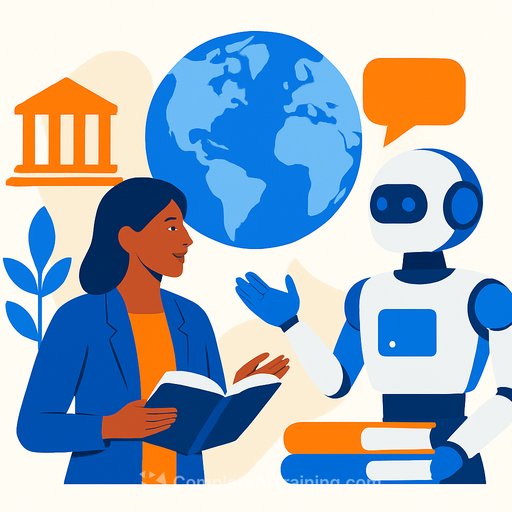Why learning a language still matters in the age of AI
AI can translate a phrase and draft a polite email. It can't teach students to read the room, hear what isn't said, or build trust across cultures. That's why language learning still matters - and why it needs an upgrade, not a eulogy.
As one education leader put it, the goal is to develop "first-class humans," not "second-class robots." Language education is one of the few school experiences that trains nuance, empathy and global competence - skills students use for life.
What AI can and can't do in language education
AI is great for drills, spaced repetition, pronunciation feedback and quick drafting. Use it to accelerate basics and free up class time. But it struggles with sarcasm, subtext, politeness strategies, and culturally appropriate choices in messy, real settings.
Students need real people, real stakes and real feedback to internalize those cues. That means partnering language instruction with lived intercultural experiences, reflection and responsibility.
Policy shifts educators should watch
Across Australia, language learning is getting fresh intent. The Australian Federation of Modern Language Teachers Association has called for a reset in how we talk about the purpose of languages - from transactional skills to global capability.
In Victoria, a new China Strategy prioritizes Chinese language and cultural literacy, sister school partnerships, and student forums to build peer-to-peer connection. A federal parliamentary inquiry is also examining how to build Asia capability through education, with an emphasis on language skills, intercultural understanding and diplomacy.
Case study: a whole-school model that pairs language with global competence
One school's approach shows what this shift looks like in practice: treat language as the entry point to culture, connection and contribution - from early learning to Year 12.
- Junior School Languages and Cultures: A new subject builds peer-to-peer learning around languages and cultures, champions bilingual and bicultural identities, and develops metalinguistic awareness. From 2026, every Year 1 class pairs with a buddy class overseas to grow international connections.
- Our closest neighbours focus: Class-to-class links with schools across Indonesia, Papua New Guinea and Timor-Leste. As students advance, they rotate buddy classes - a "trip around the world" with increasing responsibility and perspective.
- Bilingual pathways for Chinese-background students: Purpose-built subjects help students deepen knowledge of Chinese culture and society and move confidently between Australian and Chinese contexts.
- Senior School International Outlook Student Club: Students join Asia-Pacific youth forums tied to the SDGs, run video exchanges with partner schools, and host international visitors - authentic practice for cross-cultural communication.
- Staff and student cultural primers: Pre-departure training for trips (e.g., India, France, Japan, China) builds cultural knowledge and communication strategies so immersion starts on day one, not day five.
- Systematic strategy and measurement: A three-year International Outlook Strategy embeds opportunities from ELC to Senior School. Staff are trained in a Global Competence Model, and students are tracked with the Global Competence Aptitude Assessment.
Why this works
Language proficiency is the vehicle. Cultural empathy, adaptability and trust are the outcomes. By making global contact routine - not a one-off trip - students practice the nuances AI misses: tone, timing, face-saving, and how to disagree without losing rapport.
This is how you build graduates who can lead projects across borders, avoid costly missteps and collaborate with respect.
Practical moves for your school this year
- Rewrite your languages rationale around cultural literacy and global competence, not just proficiency targets.
- Pair every junior class with an international buddy class; scaffold tasks from simple greetings to joint projects.
- Create bilingual and heritage learner tracks that value home languages as an asset, not an add-on.
- Stand up a student "International Outlook" club to connect with regional forums and SDG-aligned projects.
- Introduce cultural primers and intercultural communication workshops before any trip or exchange.
- Adopt a global competence framework and track growth alongside language proficiency.
Use AI - without losing the human edge
- Let AI handle vocab drills, pronunciation practice and low-stakes writing to speed exposure.
- Have students critique AI outputs for tone, politeness and cultural fit - and rewrite for different audiences.
- Assign real interlocutors: partner classes, mentors or community speakers to test language under real conditions.
- Require reflection journals on miscommunication moments and what students would do differently next time.
- Update assessment: product plus process (planning, feedback cycles, cultural decision-making).
Measure what matters
Track proficiency, yes - and track global competence, too. The OECD's framing of global competence is a useful reference for curriculum and assessment design.
See OECD guidance on global competence
The bottom line
AI can teach phrases. Educators teach people. Keep language learning at the core, pair it with sustained intercultural experiences and measure progress beyond grammar and vocab.
That's how we graduate "first-class humans" who can think across cultures, build trust and operate with confidence in a complex international context.
Want structured AI upskilling for educators? Explore curated learning paths to use AI responsibly in teaching and assessment: AI courses by job.
Your membership also unlocks:






